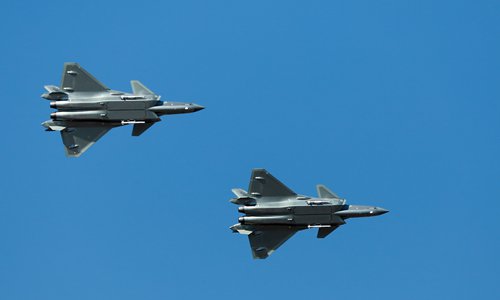China's giant wind tunnel to accelerate development of warplanes
By Liu Xuanzun Source:Global Times Published: 2020/5/27 19:09:03

China's most advanced fighter jet, J-20, performs at the Chinese Air Force's "open day" event in Changchun, Northeast China's Jilin Province on Thursday. This is the second time the stealth warplane opened its side missile bays and showcased its short-range combat missiles. They were first revealed at Airshow China 2018. Photo: IC
Under development for more than eight years, China's latest, world-leading wind tunnel is now ready to help develop new warplanes after reaching a milestone on Tuesday by successfully testing and receiving data for an in-development aircraft. With its help, China will be able to develop new warplanes faster and perform better, experts said on Wednesday.
The wind tunnel, called FL-62, conducted its first operation on Tuesday by running a test for an undisclosed new aircraft. The operation went smoothly as the flow field generated by the wind tunnel was stable and test data for the aircraft was gathered for the first time, the Aerodynamics Research Institute, under the state-owned Aviation Industry Corporation of China (AVIC), announced in a statement on Tuesday.
This successful test showed the FL-62 wind tunnel was ready to test all types of aircraft and contribute to their development, the statement said.
Approved for construction in 2012 and based in Shenyang, Northeast China's Liaoning Province, the 6,620-ton, 17,000-cubic meter machine is China's first large continuous transonic wind tunnel. It is a fundamental and strategic facility crucial to China's aviation industry, as it will decide the shape of China's future warplanes, according to information AVIC released previously.
Compared to previous Chinese wind tunnels, the FL-62 can provide more stable and consistent airflow, resulting in more realistic data gathered from aircraft models tested in the tunnel, a military expert who asked not to be named told the Global Times.
With the data, aircraft developers could optimize the aircraft's aerodynamic design, giving it better performance in speed, range, maneuverability and stealth, the expert said, noting that a more advanced wind tunnel will also likely reduce the development time because the data it generates will be more accurate.
An optimized aircraft model would eventually be made into a prototype for test flights.
Before its first operation on Tuesday, the FL-62 ran a final test on itself on Sunday, in which data showed it had reached a world-leading standard, the institute's statement on Tuesday said.
China is eyeing to develop a next-generation fighter jet by 2035 or earlier, reports in early 2019 quoted Wang Haifeng, a chief architect at AVIC's Chengdu Aircraft Research and Design Institute who also participated in the development of the J-20 and J-10 fighter jets, as saying.
The generational standards for fighter jets have been defined mainly by Western countries but not future standards, said J-20's chief designer Yang Wei in a China Central Television program, noting that China will design very different aircraft in the future through true innovation.
Posted in: MILITARY